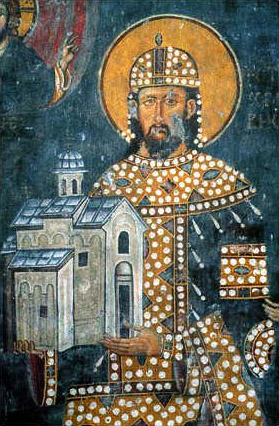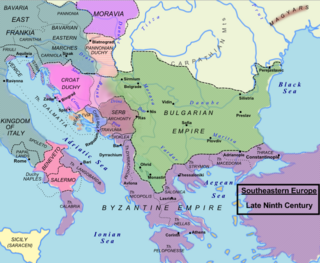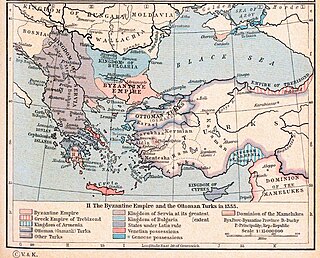Related Research Articles

Stefan Dragutin, was King of Serbia from 1276 to 1282. From 1282, he ruled a separate kingdom which included northern Serbia, and the neighboring Hungarian banates, for which he was unofficially styled "King of Syrmia".

The Principality of Serbia was one of the early medieval states of the Serbs, located in the western regions of Southeastern Europe. It existed from the 8th century up to c. 969–971 and was ruled by the Vlastimirović dynasty. Its first ruler known by name was Višeslav who started ruling around 780. While by that time, starting from the year 680–681, the Bulgarian state had taken the lands to the east. Vlastimir resisted and defeated the Bulgarian army in a three-year-war (839–842), and the two powers lived in peace for some decades. Vlastimir's three sons succeeded in ruling Serbia together, although not for long; Serbia became a key part in the power struggle between the Byzantines and Bulgarians, predominantly allied with the Byzantines, which also resulted in major dynastic wars for a period of three decades. The principality was annexed in 924 by Simeon I and subjected to Bulgarian rule until 933 when Serbian prince Časlav was established as ruler of the Serbian land, becoming the most powerful ruler of the Vlastimirović dynasty.

Zachlumia or Zachumlia, also Hum, was a medieval principality located in the modern-day regions of Herzegovina and southern Dalmatia. In some periods it was a fully independent or semi-independent South Slavic principality. It maintained relations with various foreign and neighbouring powers and later was subjected to Kingdom of Hungary, Kingdom of Serbia, Kingdom of Bosnia, and at the end to the Ottoman Empire.

Duklja was a medieval South Slavic state which roughly encompassed the territories of modern-day southeastern Montenegro, from the Bay of Kotor in the west to the Bojana river in the east, and to the sources of the Zeta and Morača rivers in the north. First mentioned in 10th– and 11th-century Byzantine chronicles, it was a vassal of the Bulgarian Empire between 997 and 1018, and then of the Byzantine Empire until it became independent in 1040 under Stefan Vojislav who rose up and managed to take over territories of the earlier Serbian Principality, founding the Vojislavljević dynasty. Between 1043 and 1080, under Mihailo Vojislavljević, and his son, Constantine Bodin, Duklja saw its apogee. Mihailo was given the nominal title King of Slavs by the Pope after having left the Byzantine camp and supported an uprising in the Balkans, in which his son Bodin played a central part. Having incorporated the Serbian hinterland and installed vassal rulers there, this maritime principality emerged as the most powerful Serb polity, seen in the titles used by its rulers. However, its rise was short-lived, as Bodin was defeated by the Byzantines and imprisoned; pushed to the background, his relative and vassal Vukan became independent in Raška, which continued the fight against the Byzantines while Duklja was struck with civil wars. Between 1113 and 1149 Duklja was the centre of Serbian–Byzantine conflict, with members of the Vojislavljević as protégés of either fighting each other for power. Duklja was then incorporated as a crown land of the Grand Principality of Serbia ruled by the Vukanović dynasty, subsequently known as Zeta, remaining so until the fall of the Serbian Empire in the 14th century.
The Chronicle of the Priest of Dioclea or Duklja is the usual name given to a medieval chronicle written in two versions between 1295 and 1301 by an ecclesiastic from Duklja, recently identified as Rudger, Archbishop of Bar. Its oldest preserved copy is in Latin from the 17th century, and modern historians have debated the text's date of composition and authenticity.

Travunia was a South Slavic medieval principality that was part of Medieval Serbia (850–1371), and later the Medieval Bosnia (1373–1482). The principality became hereditary in a number of noble houses, often kin to the ruling dynasty. The region came under Ottoman rule in 1482. Its seat was in the city of Trebinje.
The House of Vojislavljević was a Serbian medieval dynasty, named after archon Stefan Vojislav, who wrested the polities of Duklja, Travunia, Zahumlje, inner Serbia and Bosnia from the Byzantines in the mid-11th century. His successors, kings Mihailo I Vojislavljević and Constantine Bodin expanded and consolidated the state. During the 12th century, the main line of the Vojislavljević family was ousted by their cadet branch, the Vukanović. (which became the Nemanjić dynasty), in the late 12th century.
Constantine Bodin was a medieval king and the ruler of Duklja, the most powerful Serbian principality of the time, from 1081 to 1101, succeeding his father, Mihailo Vojislavljević.

The medieval period in the history of Serbia began in the 6th century with the Slavic migrations to Southeastern Europe, and lasted until the Ottoman conquest of Serbian lands in the second half of the 15th century. The period is also extended to 1537, when Pavle Bakić, the last titular Despot of Serbia in Hungarian exile, fell in the Battle of Gorjani.

Mihailo Vojislavljević was a medieval Serbian king and the ruler of Dioclea (Duklja), from 1046 to 1081 initially as a Byzantine vassal holding the title of protospatharios, then after 1077 as nominally serving Pope Gregory VII, addressed as "King of the Slavs". He had alienated himself from the Byzantines when he supported a Bulgarian Uprising of Georgi Voyteh, after which he then sought to gain support in the West. In 1077 he received a royal insignia by Gregory VII in the aftermath of the Church schism of 1054.
Stefan Vojislav was the Prince of Duklja from 1018 to 1043. Beginning in the year 1018, he served as a Byzantine governor, until 1034 when he led an unsuccessful revolt that landed him in a prison at Constantinople. He managed to escape and returned home, this time successfully gaining the independence of his statelet and expanding his rule over southern Dalmatia and its hinterland. He is the eponymous founder of the Vojislavljević dynasty.
Dobroslav II was King of Duklja, between 1101 and 1102.

The history of Bosnia and Herzegovina in the Middle Ages refers to the time period between the Roman era and the 15th-century Ottoman conquest. The Early Middle Ages in the Western Balkans saw the region reconquered from barbarians (Ostrogoths) by the Byzantine Emperor Justinian I, followed by raids and migrations carried out by Slavic peoples in the 6th and 7th centuries. The first mention of a distinct Bosnian region comes from the 10th-century Byzantine text De Administrando Imperio. By the late 9th and early 10th century, Latin priests had Christianized much of Bosnia, with some areas remaining unconverted. In the High Middle Ages, Bosnia experienced economic stability and peace under the Ban Kulin who ruled over Banate of Bosnia from 1180 to 1204 and strengthened its ties with the Republic of Ragusa and with Venice. The Kingdom of Bosnia emerged in the Late Middle Ages (1377). The kingdom faced internal and external conflicts, eventually falling under Ottoman rule in the late 15th and early 16th centuries.

The name Stephen, long popular among South Slavic monarchs, was used as an honorific or as a royal title by various rulers of Serbia and claimants to the Serbian throne, most notably the Nemanjić kings of Serbia and the Kotromanić kings of Bosnia.
The Vukanović dynasty, was a medieval Serbian dynasty that ruled over inner Serbia, centered in the Raška region, during the 11th and 12th century. Several members of the Vukanović dynasty also ruled in some other regions. The house may have descended from the Vojislavljević dynasty of Duklja. Vukanović dynasty was later succeeded in Serbia by the closely related Nemanjić dynasty.

The Bulgarian-Serbian wars were a series of conflicts between the Bulgarian Empire and medieval Serbian states between the 9th and 14th centuries in the central Balkans.
Vukan I was the Grand Prince of Serbia from 1083 until he died in 1112. During their first years he ruled together with his brother Marko. With the death of his uncle, King Constantine Bodin of Duklja in 1101, he became the most powerful ruler among Serbian princes. He defeated the Byzantines several times, conquering parts of northern Macedonia. He is the eponymous founder of the Vukanović dynasty.

The Kingdom of Serbia, or the Serbian Kingdom, was a medieval Serbian kingdom in Southern Europe comprising most of what is today Serbia, Kosovo, and Montenegro, as well as southeastern Bosnia and Herzegovina, parts of coastal Croatia south of the Neretva river, Albania north of the Drin River, North Macedonia, and a small part of western Bulgaria. The medieval Kingdom of Serbia existed from 1217 to 1346 and was ruled by the Nemanjić dynasty. The Grand Principality of Serbia was elevated with the regal coronation of Stefan Nemanjić as king, after the reunification of Serbian lands. In 1219, Serbian Orthodox Church was reorganized as an autocephalous archbishopric, headed by Saint Sava. The kingdom was proclaimed an empire in 1346, but kingship was not abolished as an institution, since the title of a king was used as an official designation for a co-ruler of the emperor.

Grand Principality of Serbia, also known by anachronistic exonym as Rascia, was a medieval Serbian state that existed from the second half of the 11th century up until 1217, when it was transformed into the Kingdom of Serbia. After the Grand Principality of Serbia emerged it gradually expanded during the 12th century, encompassing various neighbouring regions, including territories of Raška, modern Montenegro, Herzegovina, and southern Dalmatia. It was founded by Grand Prince Vukan, who initially served as regional governor of the principality, appointed by King Constantine Bodin. During Byzantine-Serbian wars Vukan gained prominence and became a self-governing ruler in inner Serbian regions. He founded the Vukanović dynasty, which ruled the Grand Principality. Through diplomatic ties with the Kingdom of Hungary, Vukan's successors managed to retain their self-governance, while also recognizing the supreme overlordship of the Byzantine Empire, up to 1180. Grand Prince Stefan Nemanja (1166–1196) gained full independence and united almost all Serbian lands. His son, Grand Prince Stefan was crowned King of Serbia in 1217, while his younger son Saint Sava became the first Archbishop of Serbs, in 1219.

Serbs of Montenegro or Montenegrin Serbs, compose native and the second largest ethnic group in Montenegro, after the ethnic Montenegrins. Additional 0.47% of the population is made up of Serbs-Montenegrins and Montenegrins-Serbs.
References
- ↑ Adalbert-Stifter-Verein (Munich, Germany) (1961). Veröffentlichungen der Wissenschaftlichen Abteilung. Edmund Gans Verlag. p. 26.
- ↑ John V. A. Fine (5 February 2010). When Ethnicity Did Not Matter in the Balkans: A Study of Identity in Pre-Nationalist Croatia, Dalmatia, and Slavonia in the Medieval and Early-Modern Periods. University of Michigan Press. pp. 36–. ISBN 978-0-472-02560-2.
- ↑ Maddalena Betti (24 October 2013). The Making of Christian Moravia (858-882): Papal Power and Political Reality. BRILL. pp. 189–. ISBN 978-90-04-26008-5.
- ↑ Armin Pavić (1906). Postanje Gundulićeva Osmana i glávâ 29-36 u Porfirogenitovoj De adm. imp. Tisak Kr. zemaljske tiskare. p. 62.
- ↑ Ćirković 2004, p. 26.
- ↑ Jireček 1911, p. 241.
- ↑ Concise Dictionary of Proper Names and Notable Matters in the Works of Dante. Ardent Media. 1968. pp. 566–. GGKEY:P53U8KC8WZR.
Addressed (in 1288) by Pope Nicholas IV as 'Rex Sclavorum'; he signed himself (in 1305 or 1307) in a document still extant in the Venetian archives as ' Stephanus Urosch Rex Serbicarum terrarum et maritimarum '. a [Stefano Urosio.] ...
- ↑ Christian Raffensperger (12 March 2012). Reimagining Europe: Kievan Rus' in the Medieval World. Harvard University Press. pp. 103–. ISBN 978-0-674-06546-8.
- ↑ "Canute VI | Viking ruler, Danish monarch | Britannica". Encyclopedia Britannica. 20 February 2024.